wheels PEUGEOT 3008 2012 Owners Manual
[x] Cancel search | Manufacturer: PEUGEOT, Model Year: 2012, Model line: 3008, Model: PEUGEOT 3008 2012Pages: 328, PDF Size: 62.62 MB
Page 39 of 328
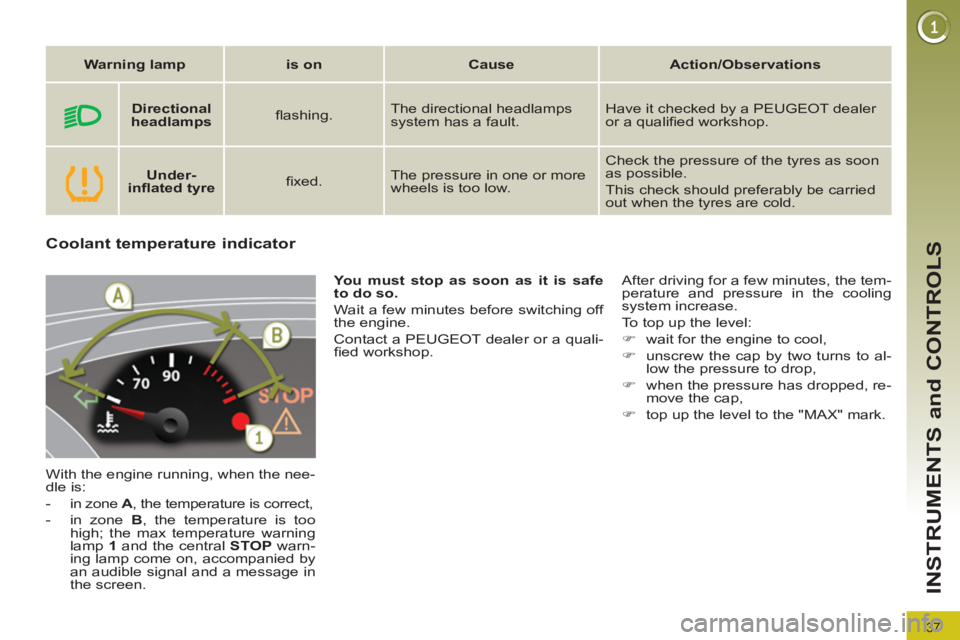
37
INSTRUMENTS and CONTROLS
Coolant temperature indicator
With the engine running, when the nee-
dle is:
- in zone A
, the temperature is correct,
- in zone B
, the temperature is too
high; the max temperature warning
lamp 1
and the central STOP
warn-
ing lamp come on, accompanied by
an audible signal and a message in
the screen. After driving for a few minutes, the tem-
perature and pressure in the cooling
system increase.
To top up the level:
�)
wait for the engine to cool,
�)
unscrew the cap by two turns to al-
low the pressure to drop,
�)
when the pressure has dropped, re-
move the cap,
�)
top up the level to the "MAX" mark.
You must stop as soon as it is safe
to do so.
Wait a few minutes before switching off
the engine.
Contact a PEUGEOT dealer or a quali-
fi ed workshop.
Warning lamp
is on
Cause
Action/Observations
Directional
headlamps
fl ashing. The directional headlamps
system has a fault. Have it checked by a PEUGEOT dealer
or a qualifi ed workshop.
Under-
infl ated tyre
fi xed. The pressure in one or more
wheels is too low. Check the pressure of the tyres as soon
as possible.
This check should preferably be carried
out when the tyres are cold.
Page 127 of 328
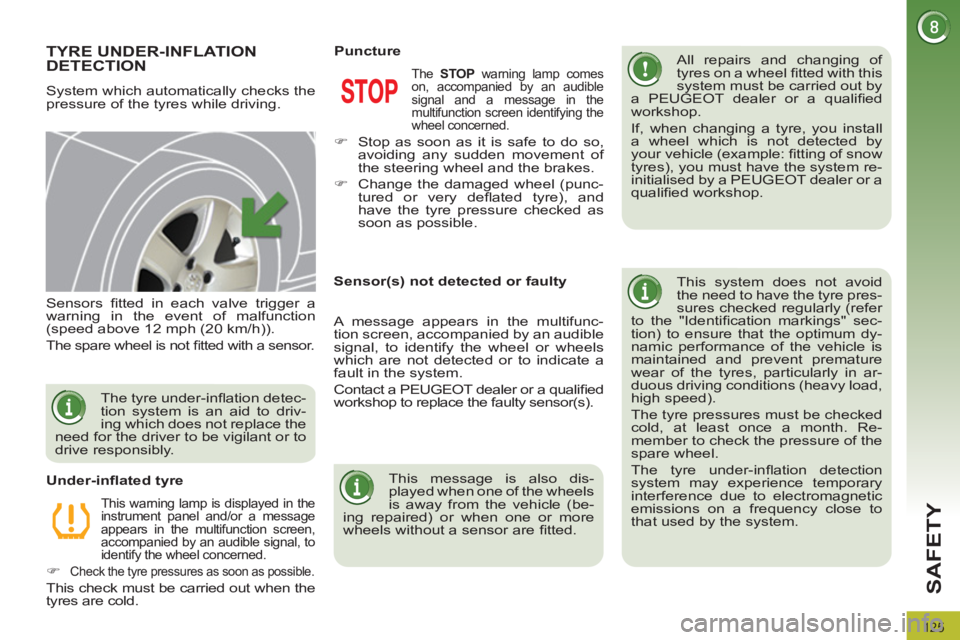
125
SAFETY
TYRE UNDER-INFLATION
DETECTION
System which automatically checks the
pressure of the tyres while driving.
All repairs and changing of
tyres on a wheel fi tted with this
system must be carried out by
a PEUGEOT dealer or a qualifi ed
workshop.
If, when changing a tyre, you install
a wheel which is not detected by
your vehicle (example: fi tting of snow
tyres), you must have the system re-
initialised by a PEUGEOT dealer or a
qualifi ed workshop.
This system does not avoid
the need to have the tyre pres-
sures checked regularly (refer
to the "Identifi cation markings" sec-
tion) to ensure that the optimum dy-
namic performance of the vehicle is
maintained and prevent premature
wear of the tyres, particularly in ar-
duous driving conditions (heavy load,
high speed).
The tyre pressures must be checked
cold, at least once a month. Re-
member to check the pressure of the
spare wheel.
The tyre under-infl ation detection
system may experience temporary
interference due to electromagnetic
emissions on a frequency close to
that used by the system.
Sensors fi tted in each valve trigger a
warning in the event of malfunction
(speed above 12 mph (20 km/h)).
The spare wheel is not fi tted with a sensor.
This warning lamp is displayed in the
instrument panel and/or a message
appears in the multifunction screen,
accompanied by an audible signal, to
identify the wheel concerned.
�)
Check the tyre pressures as soon as possible.
This check must be carried out when the
tyres are cold.
Under-infl ated tyre
The STOP
warning lamp comes
on, accompanied by an audible
signal and a message in the
multifunction screen identifying the
wheel concerned.
�)
Stop as soon as it is safe to do so,
avoiding any sudden movement of
the steering wheel and the brakes.
�)
Change the damaged wheel (punc-
tured or very defl ated tyre), and
have the tyre pressure checked as
soon as possible.
Puncture
The tyre under-infl ation detec-
tion system is an aid to driv-
ing which does not replace the
need for the driver to be vigilant or to
drive responsibly.
Sensor(s) not detected or faulty
A message appears in the multifunc-
tion screen, accompanied by an audible
signal, to identify the wheel or wheels
which are not detected or to indicate a
fault in the system.
Contact a PEUGEOT dealer or a qualifi ed
workshop to replace the faulty sensor(s).
This message is also dis-
played when one of the wheels
is away from the vehicle (be-
ing repaired) or when one or more
wheels without a sensor are fi tted.
Page 128 of 328
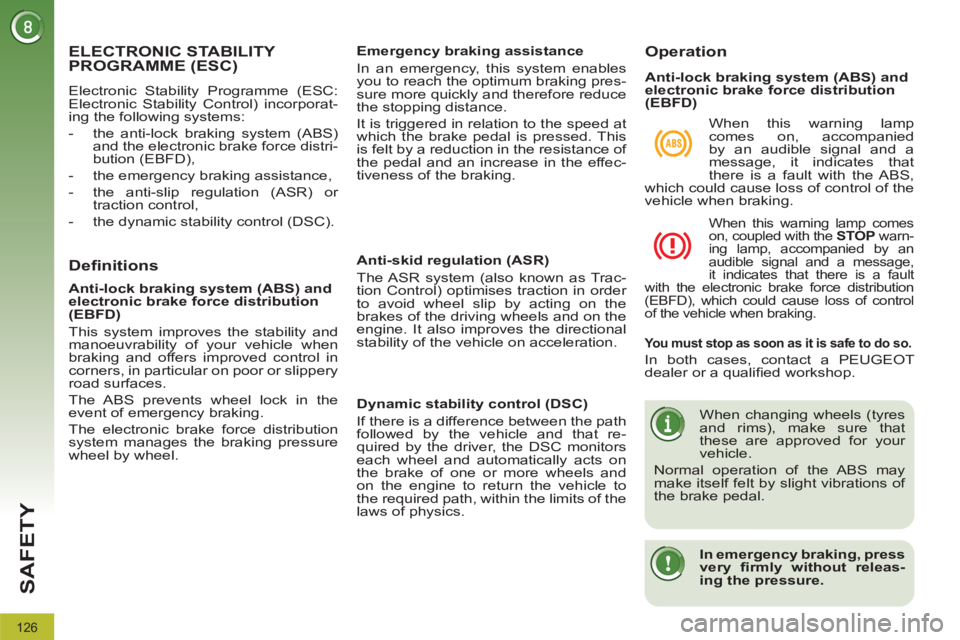
126
SAFETY
ELECTRONIC STABILITY
PROGRAMME (ESC)
Electronic Stability Programme (ESC:
Electronic Stability Control) incorporat-
ing the following systems:
- the anti-lock braking system (ABS)
and the electronic brake force distri-
bution (EBFD),
- the emergency braking assistance,
- the anti-slip regulation (ASR) or
traction control,
- the dynamic stability control (DSC).
Definitions
Anti-skid regulation (ASR)
The ASR system (also known as Trac-
tion Control) optimises traction in order
to avoid wheel slip by acting on the
brakes of the driving wheels and on the
engine. It also improves the directional
stability of the vehicle on acceleration.
Dynamic stability control (DSC)
If there is a difference between the path
followed by the vehicle and that re-
quired by the driver, the DSC monitors
each wheel and automatically acts on
the brake of one or more wheels and
on the engine to return the vehicle to
the required path, within the limits of the
laws of physics.
Emergency braking assistance
In an emergency, this system enables
you to reach the optimum braking pres-
sure more quickly and therefore reduce
the stopping distance.
It is triggered in relation to the speed at
which the brake pedal is pressed. This
is felt by a reduction in the resistance of
the pedal and an increase in the effec-
tiveness of the braking.
Anti-lock braking system (ABS) and
electronic brake force distribution
(EBFD)
This system improves the stability and
manoeuvrability of your vehicle when
braking and offers improved control in
corners, in particular on poor or slippery
road surfaces.
The ABS prevents wheel lock in the
event of emergency braking.
The electronic brake force distribution
system manages the braking pressure
wheel by wheel.
Operation
When this warning lamp
comes on, accompanied
by an audible signal and a
message, it indicates that
there is a fault with the ABS,
which could cause loss of control of the
vehicle when braking.
When this warning lamp comes
on, coupled with the STOP
warn-
ing lamp, accompanied by an
audible signal and a message,
it indicates that there is a fault
with the electronic brake force distribution
(EBFD), which could cause loss of control
of the vehicle when braking.
You must stop as soon as it is safe to do so.
In both cases, contact a PEUGEOT
dealer or a qualifi ed workshop.
When changing wheels (tyres
and rims), make sure that
these are approved for your
vehicle.
Normal operation of the ABS may
make itself felt by slight vibrations of
the brake pedal.
In emergency braking, press
very fi rmly without releas-
ing the pressure.
Anti-lock braking system (ABS) and
electronic brake force distribution
(EBFD)
Page 129 of 328
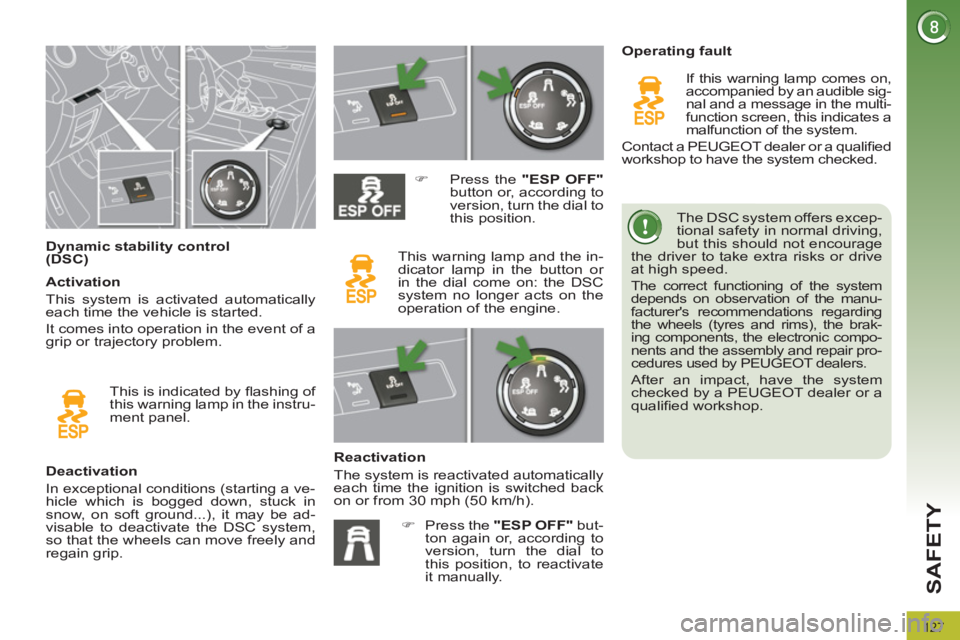
127
SAFETY
Dynamic stability control
(DSC) The DSC system offers excep-
tional safety in normal driving,
but this should not encourage
the driver to take extra risks or drive
at high speed.
The correct functioning of the system
depends on observation of the manu-
facturer's recommendations regarding
the wheels (tyres and rims), the brak-
ing components, the electronic compo-
nents and the assembly and repair pro-
cedures used by PEUGEOT dealers.
After an impact, have the system
checked by a PEUGEOT dealer or a
qualifi ed workshop.
Deactivation
In exceptional conditions (starting a ve-
hicle which is bogged down, stuck in
snow, on soft ground...), it may be ad-
visable to deactivate the DSC system,
so that the wheels can move freely and
regain grip.
�)
Press the "ESP OFF"
button or, according to
version, turn the dial to
this position.
This warning lamp and the in-
dicator lamp in the button or
in the dial come on: the DSC
system no longer acts on the
operation of the engine.
Reactivation
The system is reactivated automatically
each time the ignition is switched back
on or from 30 mph (50 km/h).
Operating fault
If this warning lamp comes on,
accompanied by an audible sig-
nal and a message in the multi-
function screen, this indicates a
malfunction of the system.
Contact a PEUGEOT dealer or a qualifi ed
workshop to have the system checked.
This is indicated by fl ashing of
this warning lamp in the instru-
ment panel.
Activation
This system is activated automatically
each time the vehicle is started.
It comes into operation in the event of a
grip or trajectory problem.
�)
Press the "ESP OFF"
but-
ton again or, according to
version, turn the dial to
this position, to reactivate
it manually.
Page 130 of 328
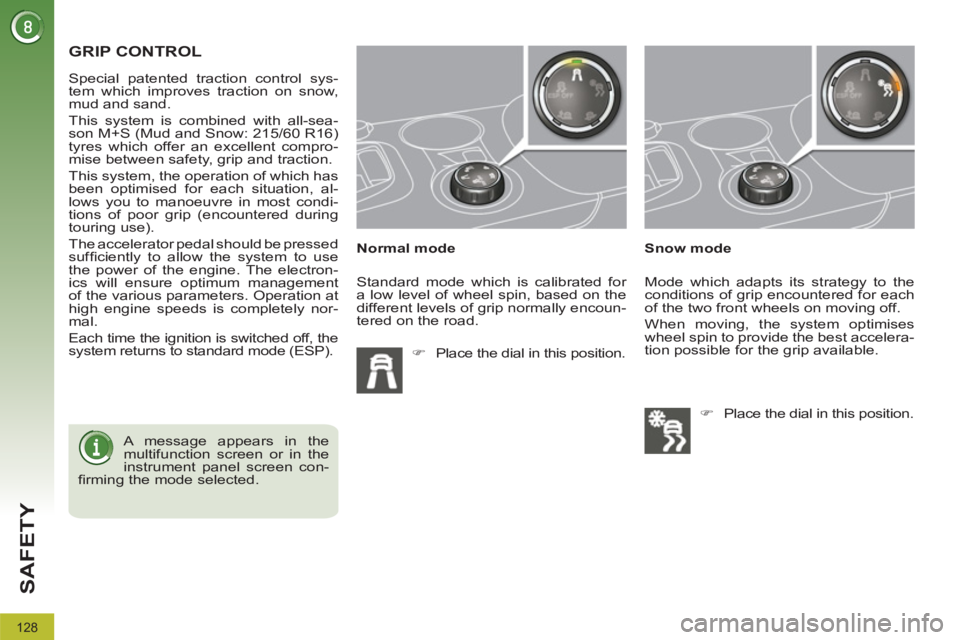
128
SAFETY
GRIP CONTROL
Normal mode
�)
Place the dial in this position.
Snow mode Special patented traction control sys-
tem which improves traction on snow,
mud and sand.
This system is combined with all-sea-
son M+S (Mud and Snow: 215/60 R16)
tyres which offer an excellent compro-
mise between safety, grip and traction.
This system, the operation of which has
been optimised for each situation, al-
lows you to manoeuvre in most condi-
tions of poor grip (encountered during
touring use).
The accelerator pedal should be pressed
suffi ciently to allow the system to use
the power of the engine. The electron-
ics will ensure optimum management
of the various parameters. Operation at
high engine speeds is completely nor-
mal.
Each time the ignition is switched off, the
system returns to standard mode (ESP). Standard mode which is calibrated for
a low level of wheel spin, based on the
different levels of grip normally encoun-
tered on the road. Mode which adapts its strategy to the
conditions of grip encountered for each
of the two front wheels on moving off.
When moving, the system optimises
wheel spin to provide the best accelera-
tion possible for the grip available.
�)
Place the dial in this position.
A message appears in the
multifunction screen or in the
instrument panel screen con-
fi rming the mode selected .
Page 131 of 328
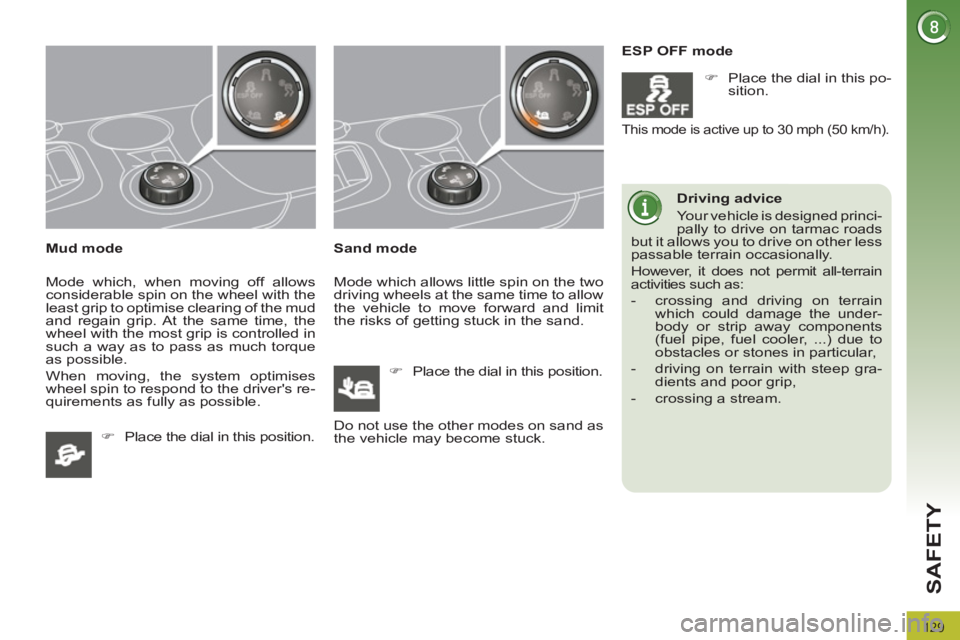
129
SAFETY
Mud mode
Mode which, when moving off allows
considerable spin on the wheel with the
least grip to optimise clearing of the mud
and regain grip. At the same time, the
wheel with the most grip is controlled in
such a way as to pass as much torque
as possible.
When moving, the system optimises
wheel spin to respond to the driver's re-
quirements as fully as possible.
Sand mode
Mode which allows little spin on the two
driving wheels at the same time to allow
the vehicle to move forward and limit
the risks of getting stuck in the sand.
Driving advice
Your vehicle is designed princi-
pally to drive on tarmac roads
but it allows you to drive on other less
passable terrain occasionally.
However, it does not permit all-terrain
activities such as:
- crossing and driving on terrain
which could damage the under-
body or strip away components
(fuel pipe, fuel cooler, ...) due to
obstacles or stones in particular,
- driving on terrain with steep gra-
dients and poor grip,
- crossing a stream.
�)
Place the dial in this position.
�)
Place the dial in this position.
ESP OFF mode
�)
Place the dial in this po-
sition.
Do not use the other modes on sand as
the vehicle may become stuck.
This mode is active up to 30 mph (50 km/h).
Page 140 of 328
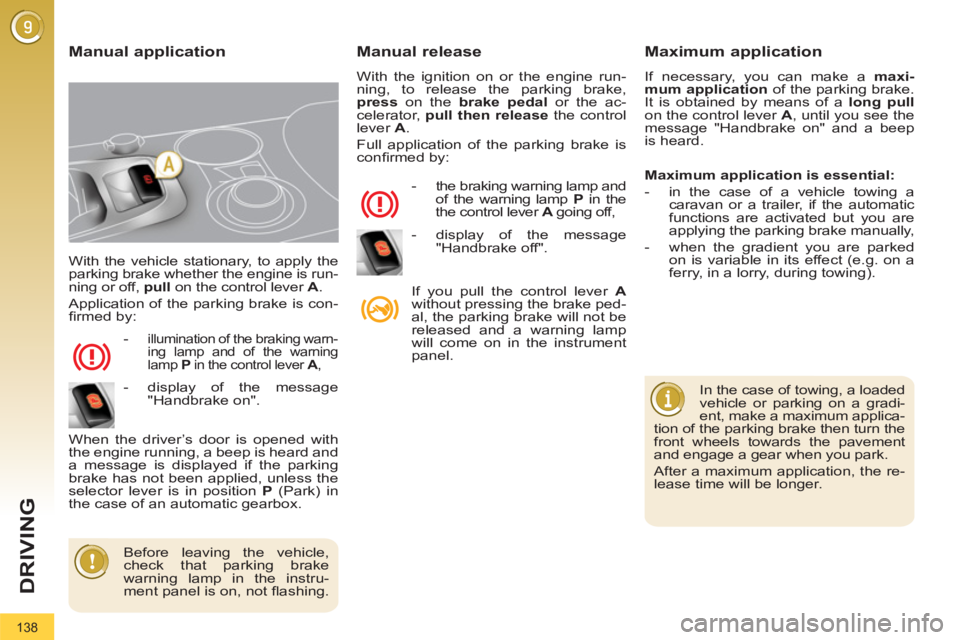
138
DRIVING
With the vehicle stationary, to apply the
parking brake whether the engine is run-
ning or off, pull
on the control lever A
.
Application of the parking brake is con-
fi rmed by:
-
illumination of the braking warn-
ing lamp and of the warning
lamp P
in the control lever A
,
When the driver’s door is opened with
the engine running, a beep is heard and
a message is displayed if the parking
brake has not been applied, unless the
selector lever is in position P
(Park) in
the case of an automatic gearbox.
Manual release
With the ignition on or the engine run-
ning, to release the parking brake,
press
on the brake
pedal
or the ac-
celerator, pull then release
the control
lever A
.
Full application of the parking brake is
confi rmed by:
- the braking warning lamp and
of the warning lamp P
in the
the control lever A
going off,
If you pull the control lever A
without pressing the brake ped-
al, the parking brake will not be
released and a warning lamp
will come on in the instrument
panel.
Manual application
Maximum application
If necessary, you can make a maxi-
mum application
of the parking brake.
It is obtained by means of a long pull
on the control lever A
, until you see the
message "Handbrake on" and a beep
is heard.
In the case of towing, a loaded
vehicle or parking on a gradi-
ent, make a maximum applica-
tion of the parking brake then turn the
front wheels towards the pavement
and engage a gear when you park.
After a maximum application, the re-
lease time will be longer.
Before leaving the vehicle,
check that parking brake
warning lamp in the instru-
ment panel is on, not fl ashing.
Maximum application is essential:
- in the case of a vehicle towing a
caravan or a trailer, if the automatic
functions are activated but you are
applying the parking brake manually,
- when the gradient you are parked
on is variable in its effect (e.g. on a
ferry, in a lorry, during towing).
- display of the message
"Handbrake on".
- display of the message
"Handbrake off".
Page 141 of 328
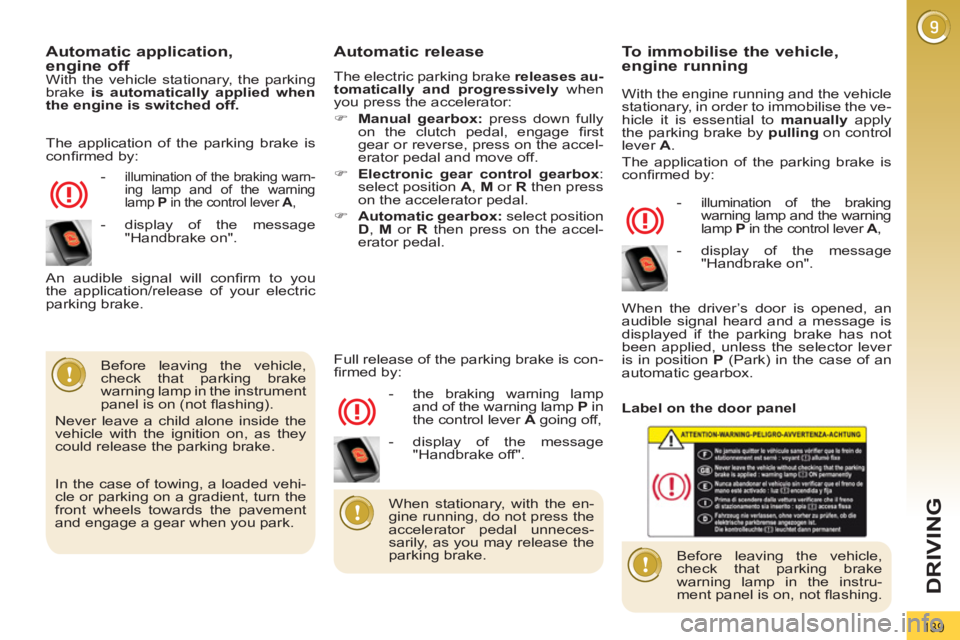
139
DRIVING
Automatic application,
engine off
With the vehicle stationary, the parking
brake is automatically applied when
the engine is switched off.
-
illumination of the braking warn-
ing lamp and of the warning
lamp P
in the control lever A
,
Automatic release
The electric parking brake releases au-
tomatically and progressively
when
you press the accelerator:
�)
Manual gearbox:
press down fully
on the clutch pedal, engage fi rst
gear or reverse, press on the accel-
erator pedal and move off.
�)
Electronic gear control gearbox
:
select position A
, M
or R
then press
on the accelerator pedal.
�)
Automatic gearbox:
select position
D
, M
or R
then press on the accel-
erator pedal.
Before leaving the vehicle,
check that parking brake
warning lamp in the instrument
panel is on (not fl ashing).
Never leave a child alone inside the
vehicle with the ignition on, as they
could release the parking brake.
- the braking warning lamp
and of the warning lamp P
in
the control lever A
going off, An audible signal will confi rm to you
the application/release of your electric
parking brake.
Full release of the parking brake is con-
fi rmed by:
To immobilise the vehicle,
engine running
With the engine running and the vehicle
stationary, in order to immobilise the ve-
hicle it is essential to manually
apply
the parking brake by pulling
on control
lever A
.
The application of the parking brake is
confi rmed by:
-
illumination of the braking
warning lamp and the warning
lamp P
in the control lever A
,
When the driver’s door is opened, an
audible signal heard and a message is
displayed if the parking brake has not
been applied, unless the selector lever
is in position P
(Park) in the case of an
automatic gearbox.
Before leaving the vehicle,
check that parking brake
warning lamp in the instru-
ment panel is on, not fl ashing.
When stationary, with the en-
gine running, do not press the
accelerator pedal unneces-
sarily, as you may release the
parking brake.
The application of the parking brake is
confi rmed by:
- display of the message
"Handbrake on".
In the case of towing, a loaded vehi-
cle or parking on a gradient, turn the
front wheels towards the pavement
and engage a gear when you park.
- display of the message
"Handbrake off".
- display of the message
"Handbrake on".
Label on the door panel
Page 143 of 328
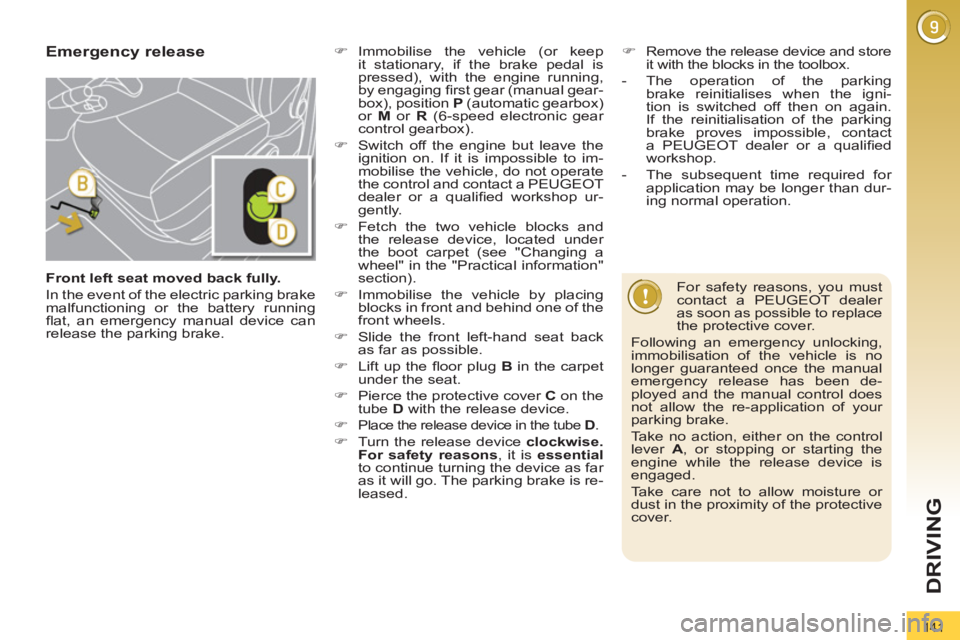
141
DRIVING
Front left seat moved back fully.
In the event of the electric parking brake
malfunctioning or the battery running
fl at, an emergency manual device can
release the parking brake.
Emergency release
�)
Immobilise the vehicle (or keep
it stationary, if the brake pedal is
pressed), with the engine running,
by engaging fi rst gear (manual gear-
box), position P
(automatic gearbox)
or M
or R
(6-speed electronic gear
control gearbox).
�)
Switch off the engine but leave the
ignition on. If it is impossible to im-
mobilise the vehicle, do not operate
the control and contact a PEUGEOT
dealer or a qualifi ed workshop ur-
gently.
�)
Fetch the two vehicle blocks and
the release device, located under
the boot carpet (see "Changing a
wheel" in the "Practical information"
section).
�)
Immobilise the vehicle by placing
blocks in front and behind one of the
front wheels.
�)
Slide the front left-hand seat back
as far as possible.
�)
Lift up the fl oor plug B
in the carpet
under the seat.
�)
Pierce the protective cover C
on the
tube D
with the release device.
�)
Place the release device in the tube D
.
�)
Turn the release device clockwise.
For safety reasons
, it is essential
to continue turning the device as far
as it will go. The parking brake is re-
leased.
�)
Remove the release device and store
it with the blocks in the toolbox.
- The operation of the parking
brake reinitialises when the igni-
tion is switched off then on again.
If the reinitialisation of the parking
brake proves impossible, contact
a PEUGEOT dealer or a qualifi ed
workshop.
- The subsequent time required for
application may be longer than dur-
ing normal operation.
For safety reasons, you must
contact a PEUGEOT dealer
as soon as possible to replace
the protective cover.
Following an emergency unlocking,
immobilisation of the vehicle is no
longer guaranteed once the manual
emergency release has been de-
ployed and the manual control does
not allow the re-application of your
parking brake.
Take no action, either on the control
lever A
, or stopping or starting the
engine while the release device is
engaged.
Take care not to allow moisture or
dust in the proximity of the protective
cover.
Page 146 of 328
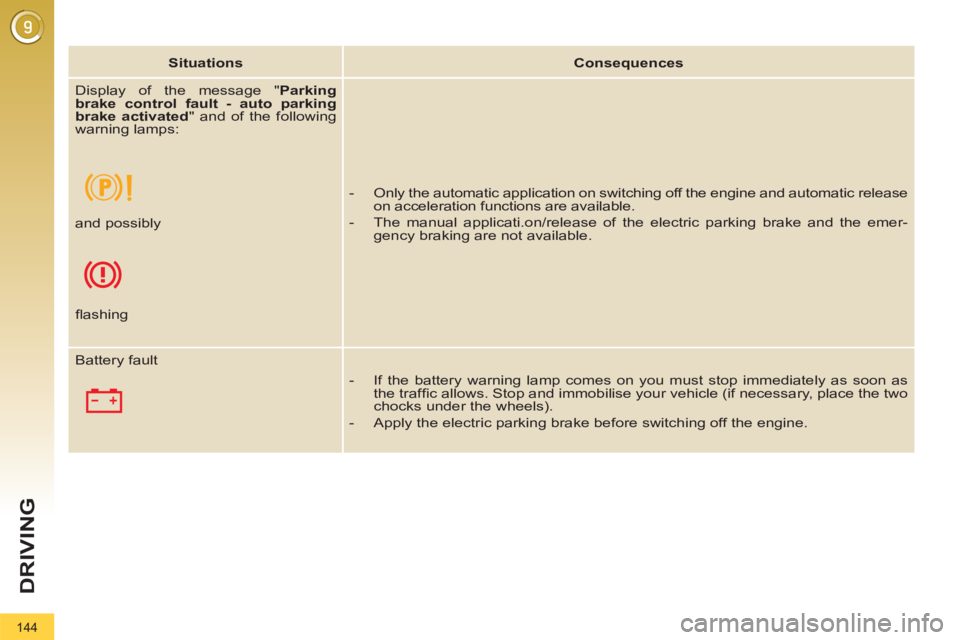
144
DRIVING
Situations
Consequences
Display of the message " Parking
brake control fault - auto parking
brake activated
" and of the following
warning lamps:
- Only the automatic application on switching off the engine and automatic release
on acceleration functions are available.
- The manual applicati.on/release of the electric parking brake and the emer-
gency braking are not available. and possibly
fl ashing
Battery fault
- If the battery warning lamp comes on you must stop immediately as soon as
the traffi c allows. Stop and immobilise your vehicle (if necessary, place the two
chocks under the wheels).
- Apply the electric parking brake before switching off the engine.